Interdisciplinary BMBF conference on the use of human embryos in medical research – Report
Bettina Stark-Watzinger, Federal Minister of Education and Research (BMBF), opened the two-day conference on 9 October 2023, inviting participants to critically reflect on and debate perspectives and ethical issues in embryo and stem cell research, including studies involving novel cell structures. Around 180 experts from various disciplines, along with representatives from politics, the media, patient groups, and interested members of the public, accepted the invitation to Berlin.


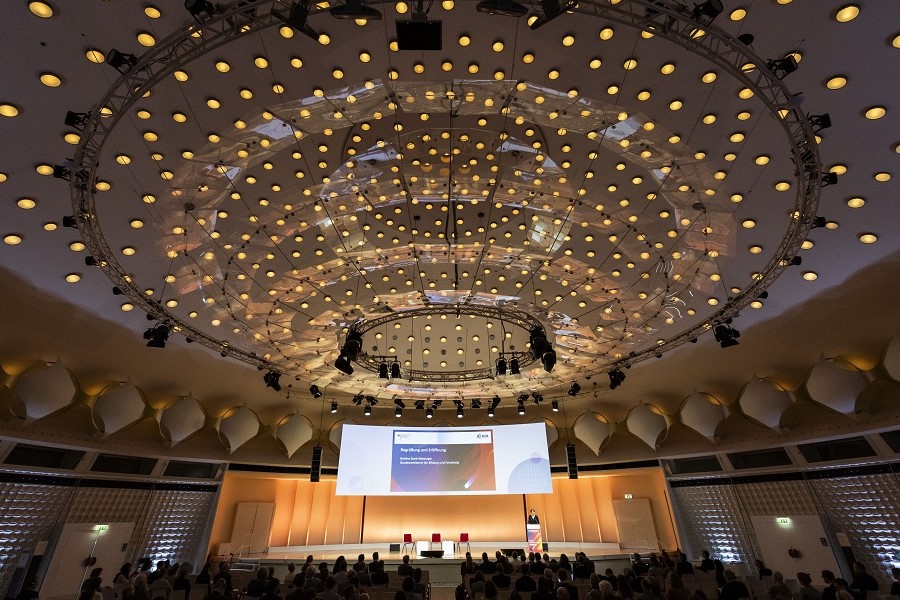
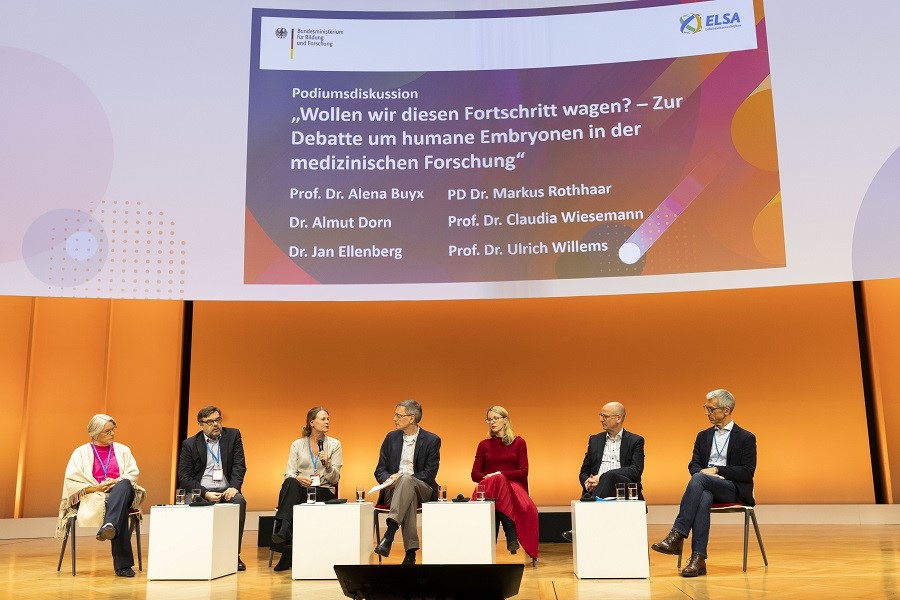
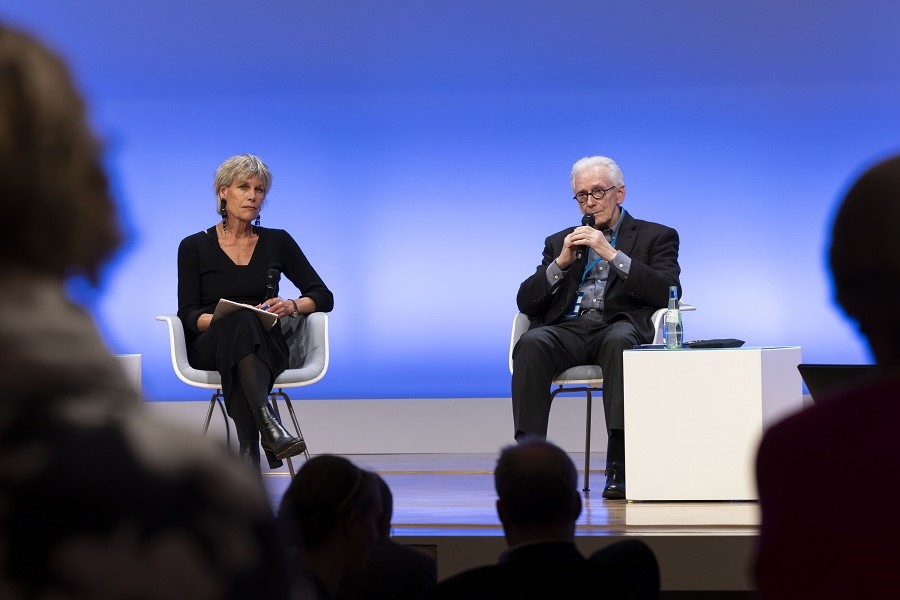
With this conference, the BMBF responded to the 2021 statement by the German National Academy of Sciences Leopoldina on research involving early embryos in vitro, aiming to generate fresh momentum for public and political discussions on ethical and legal issues.
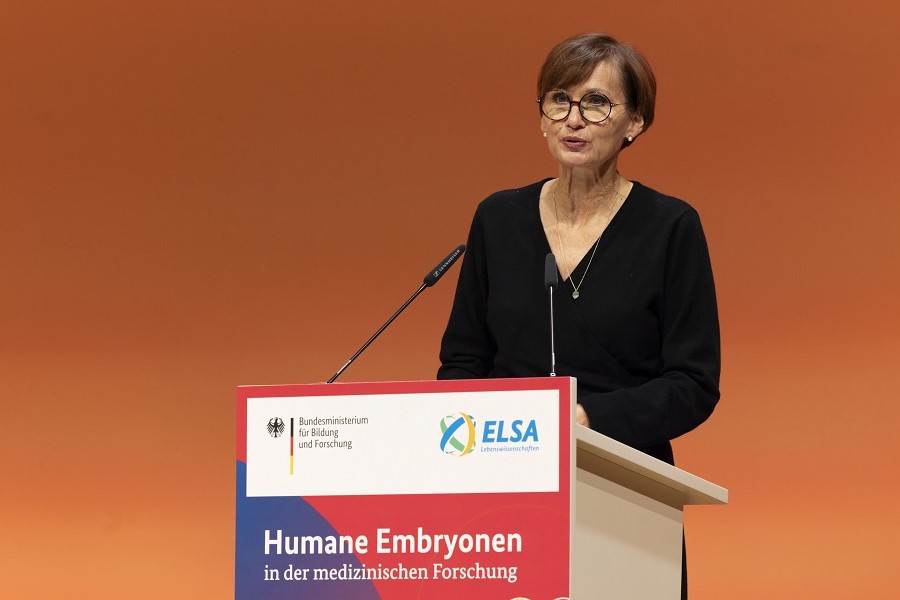
Bettina Stark-Watzinger, Federal Minister of Education and Research
BMBF / bundesfoto
In Germany, couples currently have the choice of having 'surplus' embryos either destroyed or released for adoption after completing in vitro fertilisation treatment. Embryo adoption is the exception in Germany.
The coalition agreement includes plans to allow 'elective single embryo transfer' (eSET) for in vitro fertilisation (IVF) as part of fertility treatment in the future; see also the 2019 statement by the Leopoldina on reproductive medicine. In the eSET method, several eggs are fertilised, but only the most viable embryo is selected for transfer. This leads to ‘surplus’ embryos, leaving the couple to decide what to do with them after completing fertility treatment.
Research using ‘surplus’ early human embryos could play a crucial role in improving the understanding and treatment of diseases. The use of ‘surplus’ embryos in vitro for research is currently prohibited in Germany under the Embryo Protection Act (ESchG), in force since 1990, but is permitted within strict limits in many other countries.

Prof Dr Gerald Haug, President of the German National Academy of Sciences Leopoldina
BMBF / bundesfoto
The conference provided insights into the latest scientific possibilities and perspectives on research involving early human embryos and pluripotent stem cells across various medical fields. The long-standing legal framework for embryo and stem cell research in Germany was also critically examined.
In her opening speech, Stark-Watzinger advocated re-examining and re-evaluating the regulations of the Embryo Protection Act (ESchG) and the Stem Cell Act (StZG) to do justice to the rapid developments in this area of research. After all, research with early human embryos and stem cells could help to better understand and treat diseases. Accordingly, she invited a solution-driven debate along proven ethical guidelines. The President of the German National Academy of Sciences Leopoldina, Gerald H. Haug, reiterated her call for a contemporary approach to the topic.
In a welcoming address, Haug emphasised that the reality of life should not be ignored – that people in medicine today benefit from research that is not possible in Germany itself. The future possibility in Germany for a couple to make the ‘surplus’ unused embryos obtained during fertility treatment available for high-level research purposes should be reconsidered.
The first day of the event was kicked off by Federal Minister Stark-Watzinger. She emphasised the goal of wanting to set up health research in Germany in the best possible way for the benefit of the people. She encouraged an open discussion on the possibility of developing and using new diagnostic, preventive or therapeutic procedures, also in the interests of Germany as a research location involved in international cooperation.
Researchers have recognised the potential of human embryo research for findings on human development and reproductive medicine through to personalised and regenerative medicine. The scientific community has been calling for a reassessment of the German framework conditions for several years now, and these now need to be scrutinised.
Stark-Watzinger emphasised the great value of freedom of research, which should only be restricted for good reason.
It is therefore time to re-examine and re-evaluate whether and according to which rules researchers in Germany are allowed to use early human embryos in vitro, embryonic stem cells and other novel cell structures. She invited the participants to discuss bold, sensible and scientifically sound recommendations for action for politics and society.
In his welcome address, Mr Haug noted that science has advanced significantly since the Embryo Protection Act was passed over 30 years ago. In its 2021 statement, the Leopoldina advocated for a ' modern approach to handling human embryos in vitro' and outlined what this could look like. "It is one of the greatest challenges for a democratic, pluralistic society to reach compromises on highly contentious issues", said Haug. However, in the political debate, it is especially important to consider the reality of those who benefit from medical advances – particularly research on early human embryos in vitro, which is currently not allowed in Germany. This is even more relevant now, as the coalition agreement includes plans for innovations in fertility treatment, which could result in more surplus embryos. However, surplus embryos cannot currently be donated for advanced research. Instead, they must be discarded after fertility treatment unless embryo adoption – transfer to another couple wishing to have children – is an option.
Interdisciplinary overview of the topic
In her keynote speech, developmental biologist Maria Leptin explained the cell biology of the earliest stages of embryo development. She stressed that research on early human embryos and embryo models in vitro is essential for understanding diseases and developing medical applications. This calls for a clear regulatory framework and ethical guidelines.
Medical ethicist Bettina Schöne-Seifert presented recent survey findings on the social, ethical, and legal tensions surrounding the potential liberalization of embryo and stem cell research. The findings indicate a clear interest in donating embryos for research in Germany. Medical ethicist Claudia Wiesemann argued that couples trying to conceive should, as responsible citizens, have the right to decide whether to donate their surplus embryos for research rather than discard them. Legal scholar Jochen Taupitz highlighted areas where legal clarity has been lost due to scientific advances and where revisions are needed.
Leptin provided an overview of fundamental research in cell biology. She explained fundamental concepts, including the idea of a 'model' in biological research. She stressed the importance of researchers' drive for discovery in advancing science. Biological processes must be understood, and differences between humans and animal model organisms clarified, to develop effective treatments and therapies. Leptin illustrated this with examples from the labs of Kikuë Tachibana (Max Planck Institute of Biochemistry) and Melina Schuh (Max Planck Institute for Interdisciplinary Natural Sciences), whose research has provided insights into why egg cells age and how chromosome misdistribution occurs during cell division.
As President of the European Research Council, she reiterated that despite varying framework conditions across Europe, research benefits all European citizens.
Schöne-Seifert outlined the medical-ethical perspectives on the conference topic. She noted that questions about embryo protection at different developmental and biological stages are crucial not only for research but also for abortion and prenatal selection. In all these contexts, ethical standards for handling embryos should be clear, consistent, and well-justified. International research focuses on embryos in the early stages of their first 14 days of development, as longer cultivation in the lab has not yet been technically possible. At this early stage, embryos are far from resembling a human or possessing any capacity for sensation or consciousness. This is even more true for recently developed research models, such as embryoids and other embryo-like structures.
According to Schöne-Seifert, the debate over the ethical acceptability of such research should not be framed as a conflict between those who take embryo protection seriously and those willing to compromise for the sake of research. Rather, proponents of research (herself included) also base their position on ethical arguments: the moral costs of a research ban for science, patients, and researchers would be too high, while arguments for protection – especially the widely cited potentiality argument – would lack broad consensus.
Finally, Schöne-Seifert presented the results of a new survey, which clearly highlights the population's diverse views on the use of human embryos in research: around 20–30% of respondents held strongly positive views on embryo protection and donation for research, while a similar percentage were strongly opposed. The medical ethicist concluded, "We need to thoroughly reconsider and openly debate all the reasons [...] [behind the existing research ban in our country]."
Wiesemann discussed the social perspective on the conference topic and mentioned Germany’s first IVF baby, conceived through artificial insemination and born in 1982. She believes the critical discourse on potential abuse and dystopian scenarios that emerged at the time laid the foundation for the strict regulations of the Embryo Protection Act (ESchG). However, the global advancement of fertilisation technology has also expanded opportunities for basic embryological research and reproductive medicine, including cryopreservation, sperm injection (ICSI), pre-implantation diagnostics and elective single embryo transfer (eSET). This has significantly reduced infertility rates, as well as pregnancy and premature birth complications. Wiesemann noted that "alongside the rightly outlawed misuse of research, there is also highly valuable research that helps preserve life, improve human reproduction and expand knowledge of health and disease", benefiting Germany as well.
She called for a reassessment of Germany's stance on embryo research and the moral status of the embryo. The perspective of prospective parents must also be considered. The current ESchG only permits couples to cryopreserve, discard or donate surplus embryos. Wiesemann noted that many of these couples would also like the option to donate unused embryos for research.
Taupitz stated that Germany currently lacks a modern law governing reproductive medicine. The Embryo Protection Act (ESchG) of 1990, now over 30 years old, and the Stem Cell Act (StZG) of 2002 and 2008 are internally inconsistent and not well aligned with each other. Although the ESchG aims to prevent the creation and misuse of surplus embryos, it does not offer comprehensive protection. In many cases, surplus or genetically affected embryos must be left to perish or actively discarded due to a lack of alternatives. Embryos created in violation of the law must also be discarded.
The StZG, in turn, regulates the import and use of embryonic stem cells. The issue for German researchers is that the embryonic stem cell lines permitted for import no longer meet modern research standards for collection and cultivation due to Germany’s current cut-off date (1 May 2007). Additionally, current German law restricts international research collaboration.
Furthermore, recent advancements in embryo and stem cell research, such as embryoids and embryo-like cell structures, have raised the question: "What exactly is an embryo?". These developments have clearly highlighted gaps in German law. A new Reproductive Medicine Act must constitutionally consider the requirement of balancing competing interests. A proper balance must be struck between the fundamental rights to human dignity, personal development, physical integrity, and the freedom of science and research.
Specialist presentations and discussions
The conference focused on concise expert presentations from the natural sciences and medicine, as well as legal and humanities perspectives. The focus was on the opportunities and potential of in vitro embryo research, as well as its ethical and legal limitations and challenges (-> Session 1). Additionally, research on human pluripotent stem cells and novel cell structures, such as embryoids, was highlighted. (-> Session 2).
Experts outlined the vast knowledge gained from international embryo research and how it continues to inform medical care, particularly in in vitro fertilisation. Embryo research forms the foundation of stem cell research, as new cell lines are derived from embryos. For stem cell research, experts highlighted potential medical applications, such as advancements in cell therapeutics and regenerative therapies. The advantages and disadvantages of human embryonic and induced pluripotent stem cells for various research goals were discussed.
Session 1: The necessity of in vitro research on human embryos and its ethical and legal implications
The first day of the conference focused on the potential of embryos for research and medical applications, as well as the limitations faced by researchers in this country. It became evident that existing regulations, particularly those on embryo research, are restricting scientific progress in Germany and hindering international collaboration.
The various regulatory frameworks abroad that allow researchers to conduct studies on and with human embryos were also outlined. It became evident that modern medical care in Germany would lag behind by years, even if the country could benefit from advancements made elsewhere. As a result, research and politics would struggle to fulfil their responsibility to society.
Niakan provided an overview of the scientific findings that can be achieved through research on human embryos. She outlined some of her laboratory's research questions. She is particularly interested in how the three cell types that define the embryo and placenta in the earliest embryonic stages develop from a fertilised egg. Her laboratory identified relevant transcription factors and uncovered differences between the molecular programmes of various species. By selectively activating and deactivating various factors in laboratory experiments, the researchers identified biomarkers that enhance the successful development of artificially fertilised embryos. This underscores the importance of research on human embryos. She also outlined the British regulatory framework that permits research on and with human embryos in the UK. She also outlined the UK’s regulatory framework for research on and with human embryos. Niakan noted that she could not pursue several promising research questions and techniques with leading research groups in Germany due to legal restrictions. This includes, for example, Ellenberg’s group at EMBL. Such restrictions significantly slow scientific progress, both in Germany and in other locations that could benefit from collaboration.
Clark explanined how in vitro research on human embryos is conducted in her laboratory. She explained how she and her team establish contact with couples undergoing fertility treatment and inform them about research and the option to donate surplus embryos. She also outlined the regulatory and ethical bodies that must approve her research and how it is monitored.
A significant part of Clark’s research focuses on the development of the reproductive system and its disorders, which often lead to infertility. The knowledge she has gained will contribute to improving artificial fertilisation.
However, her laboratory also derives new human embryonic stem cell lines, which remain the gold standard in research. One of her working group’s goals is to develop an egg cell model to better understand how egg cells can be preserved as women age.
As a former president of the International Society for Stem Cell Research (ISSCR), Clark also explained the varying regulations for different embryo models.
Ellenberg explained that German scientists are unable to actively contribute to many research questions on human embryonic development. Neither the technologies developed in Germany nor the country's developmental biologists can be involved in projects involving embryo research. As a concrete example, he mentioned a light-sheet microscopy method developed at EMBL, which has garnered significant international interest. This microscopy technique can only be used in laboratory or farm animals, not in human embryo research, even if conducted abroad. This is because technological and methodological collaboration is prohibited in Germany even when legal and ethical standards in other countries are met.
Ellenberg emphasised that restrictions on research freedom and international collaboration not only disadvantage Germany as a business location but also set back modern medical care by years, particularly in identifying and treating genetic diseases, addressing birth defects and using embryonic cells for regenerative and personalised medicine.
He stressed that science carries a high level of responsibility and that it is essential to discuss the objectives requiring embryo research, including in Germany.
Legal scholar Bartha Knoppers outlined the legal frameworks different countries use to regulate embryo protection. She highlighted various national regulations as examples to compare them with German law. In this complex field, it is essential to consider how different cultures attribute legal and dignitary protection to the embryo. A widely supported appeal in the interdisciplinary plenary session called for amending the Embryo Protection Act with societal involvement. It is the legislator's responsibility to make sensible use of its available discretion.
Constitutional law expert Friederike Wapler outlined the legal framework that authorises legislators to shape the law. Various legal interests, such as freedom of research and embryo protection, must be carefully balanced. The broader purpose of the research could serve as a benchmark, similar to stem cell regulations.
Knoppers outlined the diverse legal approaches and administrative frameworks for managing human embryos in vitro at international, regional, and national levels. She also discussed the Council of Europe’s Bioethics Convention (Oviedo Convention). Knoppers highlighted the wide range of legal approaches in regulatory depth – for example, while Germany, Austria and Spain legally define the embryo, the UK successfully operates without such a definition.
She also highlighted the USA as a special case, where embryo research is not outright prohibited but is explicitly excluded from federal funding.
She explained that the varying regulations on human embryo research stem primarily from different historical, social and political influences. These differences influenced both the permissibility of research and the associated sanctions. Knoppers illustrated this with examples from Canada, as well as China, South Korea and several European countries.
Wapler explained that German constitutional law provides only a broad framework within which legislators are authorized to shape the law. The Basic Law cannot provide clear answers to ethically complex and socially contested questions but can only establish fundamental guidelines. In the context of human embryo research, both the constitutional status of prenatal human life and any corresponding state duty to protect it are contested, as are the legal standards for regulation.
Wapler outlined the current constitutional perspectives on the treatment of prenatal human life and highlighted the legislative flexibility available for research in this area. A key aspect is justifying the need for embryos in research to balance embryo protection with the importance of certain research objectives.
According to Wapler, the lack of clear solutions in the Basic Law is not a problem for her as a constitutional lawyer. After all, the Basic Law is designed to facilitate open democratic debate.
In the trialogue, medical ethicist Christiane Woopen, theologian Wolfgang Huber and philosopher Michael Quante discuss the challenges of addressing this topic in a pluralistic society. Pluralism refers to the diversity of social opinions shaped by different cultures and worldviews. There are various approaches to the sensitive topic of the beginning of life. It was agreed that this was a crucial step in the debate, as it's essential to be able to argue on equal terms in our society. This is less about reaching consensus and more about the tolerance to accept other perspectives. This needs a suitable framework that provides room for information and the expression of opinions. Ultimately, a clear justification of the legal regulations is essential, meaning taking a reliable factual and data-based approach while also considering alternative arguments. It is also important to acknowledge opposing positions and different moral convictions, as different beliefs must be able to coexist peacefully in our democracy.

‘Panel discussion with (from left to right) Claudia Wiesemann, Markus Rothhaar, Almut Dorn, presenter Volkart Wildermuth, Alena Buyx, Ulrich Willems and Jan Ellenberg’
BMBF / bundesfoto
The following panel discussion on the question "Do we want to dare to pursue this progress?" took a similar direction. It was attended by experts from various fields: psychological psychotherapist Almut Dorn who works with couples wishing to have children, Claudia Wiesemann, who researches the ethics of parenthood and family in reproductive medicine, and Alena Buyx, medical ethicist and chair of the German Ethics Council. Additionally, philosopher Markus Rothhaar who addresses medical ethics at the beginning and end of life, political scientist Ulrich Willems who studies cultures of compromise, and molecular biologist Jan Ellenberg, who believes freedom of research is severely restricted in Germany, provided further perspectives.
The discussion focused on how to handle the diversity of opinions in our democratic and pluralistic society. It is important to reflect this diversity of opinion in discussions on new regulations for embryo and stem cell research and to find solutions that are acceptable to all. This does not necessarily mean that consensus should be sought, but rather a compromise that acknowledges the pluralistic view as a foundation.
At the start, psychological psychotherapist Almut Dorn addressed the presenter’s question about how willing couples are to donate an embryo no longer needed for their own reproduction to science. To explore this, she conducted a small study in her practice: she asked her patients individually and received a wide range of answers – from the unimaginable, such as the fantasised child, to the obvious, with some feeling they owed their own child to research.
This impression aligned with current survey results (cf. here), which ethicist Claudia Wiesemann also referenced, indicating that the question of embryo donation for research purposes is not universally rejected today, but is viewed in a highly nuanced way. She suspects that "if it were clearer to the public that we might be protecting the embryo better than a more developed foetus during pregnancy, we could likely achieve even higher approval ratings for research at this very early stage." It is important to recognise that the purpose of the research is not "speculative futurology", but has already led to real improvements in foetal survival.
Philosopher and medical ethicist Markus Rothhaar responded to the criticism of the Embryo Protection Act by stating that, in his opinion, the law had successfully achieved an important goal: keeping artificial fertilisation as close as possible to natural fertilisation and minimising the number of surplus embryos. Once there are surplus embryos no longer needed for in vitro fertilisation, one faces the serious ethical dilemma of either preserving them indefinitely or destroying them. This is because using them for research purposes also involves their destruction. From this, the Embryo Protection Act rightly concluded that the creation of surplus embryos should be minimised as much as possible, if not completely prevented by law.
Chair of the German Ethics Council (DER), Alena Buyx, referred to a decision tree that the Ethics Council had drawn up as part of its 2019 statement on germline interventions. Accordingly, "If embryo research is needed to develop answers, not only is it permissible, but necessary", says Buyx. The diversity of opinions in the country was also reflected within the Ethics Council, and not everyone fully agreed with the DER’s recommendation. However, the best way to handle such differences was to make them transparent.
Political scientist Ullrich Willems confirmed that such complex conflicts are difficult to resolve through majority decisions. Willems explained that a challenge for various commissions is that they reflect the dissent and diversity of opinions within the population. On some issues, however, finding a middle ground is difficult. It is far more important to acknowledge minority opinions inclusively and engage with them on equal terms. Regarding embryo research, the goal is not "to be right on the merits, but to ensure forms of social coexistence that are reasonably acceptable to everyone while reducing the conflict's intensity and potential for escalation", said Willems. The social sciences can contribute to finding solutions.
But what type of research should be considered in this discussion? According to molecular biologist Jan Ellenberg, the significance of a research goal must be judged by its ultimate contribution to society. However, he cautioned that limiting research to direct medical applications would be too short-sighted. For many diseases, understanding the underlying (e.g., genetic) basis and mechanisms is the first priority. Therefore, basic research should not be overlooked in discussions on high-level research.
Several speakers on the panel viewed the lack of open debate in Germany in recent years as a problem. Science can hardly speak freely, as this research is explicitly prohibited under criminal law, while the affected decision-makers and in vitro fertilisation patients are stigmatised and marginalised. According to Wiesemann, however, the discussion should take place publicly. In light of this, Dorn added that patients with acute problems often overestimate current medical capabilities and cannot always be helped as comprehensively as they hope. It is therefore entirely understandable that this creates a desire to support research in some way.
When asked whether learning indirectly from other countries' progress was enough, Ellenberg noted, “We always adopt it five to ten years later based on knowledge gained abroad.” As a nation of science and technology, we cannot settle for this.
Ellenberg and Dorn agreed that people seek help wherever it is available. One example is hereditary diseases treatable with mitochondrial replacement therapy, which is permitted in the UK but not in Germany. The lively discussion, with contributions from many participants, highlighted ongoing controversies over human dignity and embryo protection that remained unresolved. However, there was a broader consensus that Germany acting as a moral free rider did not align with the panellists' desired image. There was also broad agreement and confidence in the need to further stimulate social discourse, as recent discussions have shown how social compromises can be successfully reached.
Evening lecture: James F. Childress on ethical principles in human embryo research
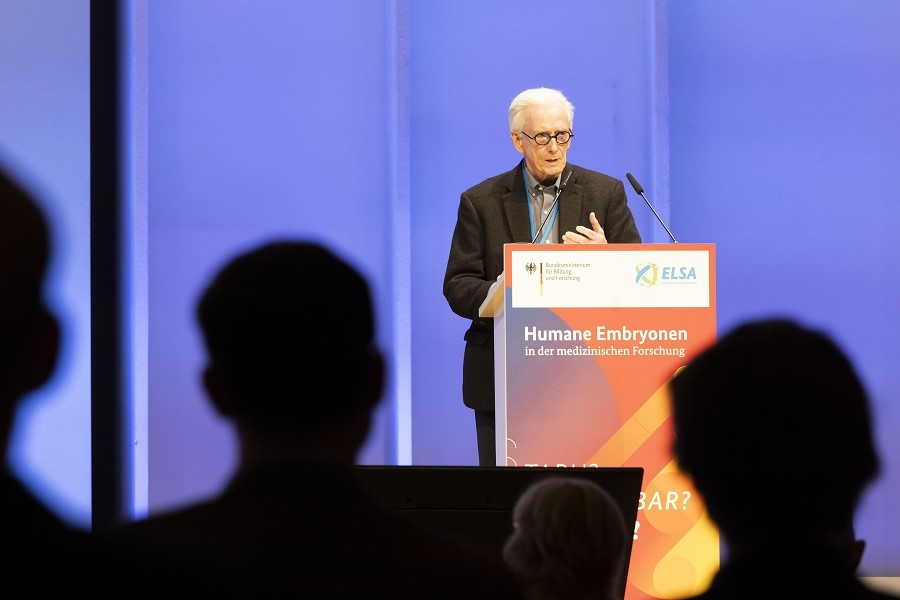
Professor em. James F. Childress
BMBF / bundesfoto
In his evening lecture James Childress, US theologian and medical ethicist, presented the four basic principles of bioethics: beneficence, avoidance of harm, justice and respect. Together with American moral philosopher Tom Beauchamp, Childress developed the so-called four-principles model of medical ethics in 1979, which serves as a framework for evaluating medical decisions. In his lecture, he applied these principles to research on early human embryos and their derivatives. The four-principles concept prioritises beneficence, meaning the pursuit of benefits such as advancing medical knowledge and developing effective therapies through research. Harmful interventions should be avoided, adhering to the principle of non-maleficence. The third principle emphasises fairness in balancing benefits and risks, as well as burdens and costs. The principle of fairness can be used to criticise moral free-riding, where a society bans human embryo research while benefiting from the knowledge or stem cell lines produced by others. Another fundamental principle is respect for personal autonomy, which ensures voluntary and informed decision-making. The free choice of couples should not be overlooked when considering the donation of surplus embryos for research.
Session 2: Stem cells and derivatives: Scientific, ethical and legal implications
Developmental biologist Christine Mummery introduced the different types of stem cells, focusing on the applications of induced pluripotent stem cells (iPSCs) and embryonic stem cells. This included the creation of various organoids for studying disease models and testing drug efficacy and tolerability.
Stem cell researcher Frederik Lanner highlighted another application of pluripotent stem cells: their use in cell replacement therapy. He cited the development of a therapy for a specific form of age-related macular degeneration as an example. German researchers are barred from such application-oriented research under the current legal framework.
Two representatives of the Central Ethics Committee for Stem Cell Research (ZES) outlined its role and highlighted the specific restrictions faced by researchers in Germany. According to Hans Schöler, this includes the restriction under the Stem Cell Act (StZG) that prohibits research using cell lines obtained after 1 May 2007 (the so-called "cut-off date regulation"). Additionally, the Stem Cell Act (StZG) in Germany permits research for high-level objectives but prohibits the use of stem cells for therapeutic applications (Section 5 StZG, known as the "research proviso"). Antonio Autiero proposed reconsidering the rationale behind the Stem Cell Act (StZG) and adopting a dynamic approach to life protection based on a graduated concept of dignity.
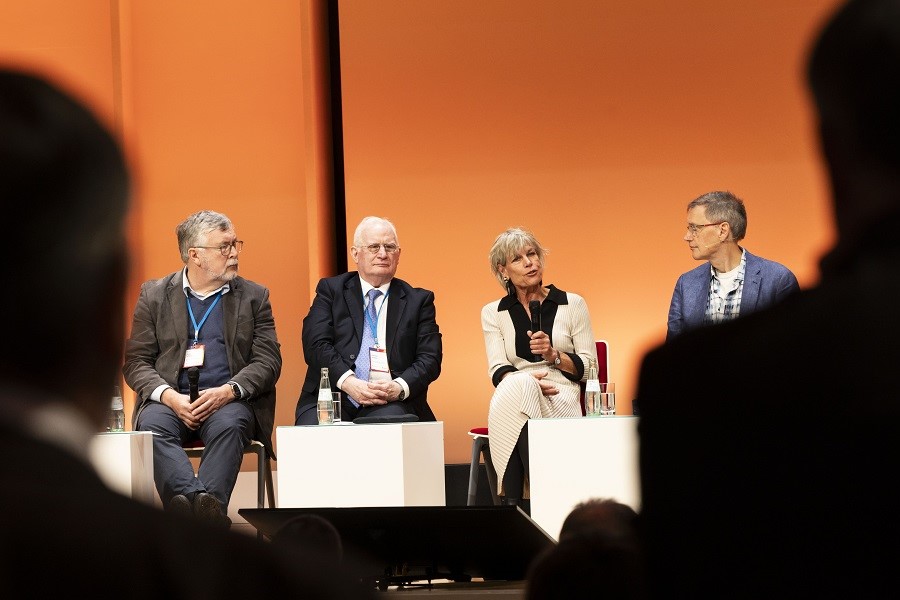
Open discussion round with (from left to right) Hans Schöler, Antonio Autiero, Bettina Schöne-Seifert, and moderator Volkart Wildermuth.
BMBF / bundesfoto
May Evers, a patient representative, highlighted the high expectations patients have for new therapies and noted that those affected struggle to understand the restrictions on stem cell research and development. In this context, ethicist Mats Hansson compared the opinions of the Swedish population: his study shows that Swedish society strongly supports using surplus embryos for medical purposes. He explained that acceptance largely depended on how well-informed potential donors were.
Legal scholar Hans-Georg Dederer outlined the legal framework for stem cell research. He highlighted the weaknesses and challenges of the prohibition-based legal regulations, which must be addressed when revising the current legal framework. This included revising the definitions in the ESchG and StZG to align with current scientific knowledge, as they do not clearly account for novel cell structures. Medical ethicist Bettina Schöne-Seifert elaborated on one of these new cell structures, the so-called embryoids or embryo models. These embryo-like structures have recently been developed and used as models to study early embryonic development. Clear and sustainable terminology is essential for navigating this rapidly evolving field and defining its boundaries. This would also help non-scientists identify when research approaches ethically sensitive areas.
Mummery provided an overview of stem cells, their types and their applications. She outlined the three types of stem cells, each with varying developmental potential. This ranges from the limited developmental potential of adult stem cells to pluripotent embryonic stem cells, which can differentiate into any cell type in the body.
Despite their limited developmental potential, adult stem cells offer valuable applications in specific areas. For example, in cystic fibrosis, laboratory tests using adult stem cells can help identify which medication a patient will respond to best. Induced pluripotent stem cells (iPSCs) and embryonic stem cells (ES) differ significantly in both their derivation and their clinical applications. For example, the two cell types differ in terms of patient safety. This is because iPSCs are derived from somatic cells, which are genetically older than ES cells and may have accumulated more genetic mutations. This, in turn, increases the risk of tumour formation. Many iPSCs are also protected by patents.
In addition to cell lines, Mummery explained the concept of artificial germ cells and organoids, particularly brain organoids, which are typically derived from adult organ cells and embryonic stem cells.
Lanner outlined his research over the past decade. One of his scientific goals is to develop a stem cell-based therapy for dry age-related macular degeneration. This form of the disease is currently untreatable and causes severe vision loss in affected individuals. In his application-oriented research, obtaining a stem cell line produced under clinical conditions was essential for its use in clinical trials and potential future therapies. Lanner reported that after years of work, his team successfully derived this cell line from surplus human embryos and is now testing it in animal experiments. These laboratory experiments were successful, and in collaboration with an industry partner, the next stage of drug development began with preclinical study packages. A clinical trial is now being launched. He demonstrated how human embryonic stem cells could enable a highly specific treatment and potential cure, while also highlighting the lengthy development process and the recurring challenges researchers face.
At the same time, Lanner noted that older stem cell lines are often unsuitable for developing cell products or therapeutics, as they no longer meet current medical guidelines, such as specific cultivation media and additives.
Schöler outlined the role and perspective of the Central Ethics Committee for Stem Cell Research (ZES).
On behalf of the Robert Koch Institute, the interdisciplinary commission evaluates the ethical justifiability of scientific projects under the Stem Cell Act (StZG) based on defined criteria: the high relevance of the research objective, prior validation in animal models, and the absence of alternatives to using human stem cells. Given recent advances, the ZES advocates expanding the definition of high-level research objectives beyond basic research to include the application of research findings. The pre-clarification requirement should not be limited to experiments with animal cells or models but should also include other pre-clarifications, such as those using human cells. Additionally, the ZES is considering whether to eliminate the cut-off date regulation and the research proviso without replacement. The use of human stem cells should also be permitted for medical applications and therapeutic development, requiring the removal of research restrictions.
In particular, the criminal penalties for violations of the Stem Cell Act (StZG) should be reassessed. In the context of induced pluripotent stem cells (iPSCs) and their potential use in transplants, the impact of genetic and epigenetic mutations, as well as cell age, must be considered, as mutations are expected to accumulate over time.
Autiero noted that the debate on stem cell research often served as a platform for discussing the moral status of the human embryo, which significantly polarised the discussion. He therefore advocated for a constructive approach to consensus-building within a pluralistic society in the interest of the common good. Regarding the moral status of the embryo, the theologian urged the development of new ways of thinking and the inclusion of diverse opinions and worldviews to enable a meaningful discussion on handling surplus embryos. He advocated for an action-oriented, responsible reassignment of surplus embryos, framing them as an opportunity to contribute to research and benefit humanity. Finally, he called for "daring to shift from a static, defensive approach to an evolutionary, dynamic and holistic understanding of life protection".
May Evers, patient representative Hilde Ulrichs Foundation for Parkinson’s Research
May Evers a Parkinson’s patient herself, described the daily challenges faced by those with the disease and the potential benefits of new stem cell-based therapies. For those affected, there is great hope that these new treatment methods could offer not only treatment but possibly a cure. Stem cell-based therapies for Parkinson’s disease are already being developed and tested in other countries. Evers stressed that patients in Germany should also have access to the best possible treatment. From the perspective of those affected, it is difficult to understand why stem cell-based therapy and research are currently not possible in Germany due to legal restrictions.
Hansson outlined the perspectives of patients and the general public in Sweden on using human embryonic stem cells for medical purposes. He described a shift in moral and social attitudes towards the use of human stem cells, moving from general rejection to a more nuanced consideration of the benefits and risks. Hansson presented a study in which a representative survey of the Swedish public was used to analyse what would be considered an acceptable use of human embryonic stem cells. He showed that there is broad acceptance for using surplus embryos for a beneficial medical purpose, but emphasised that both the embryos and their donors should be treated with respect.
He believed the situation could be similar in other countries if citizens were surveyed and given a choice.
Hansson concluded by sharing that human embryonic stem cells are now being used in preliminary studies in Sweden for Parkinson's disease treatment.
Dederer explained the legal framework governing research with embryonic stem cells in Germany, as outlined in the Embryo Protection Act and the Stem Cell Act. Under current legislation, the generation, import and use of human embryonic stem cells for research purposes are prohibited. Stem cell lines created before 1 May 2007, may only be imported and used in Germany under specific conditions, with approval from the Robert Koch Institute and a prior opinion from the Central Ethics Commission for Stem Cell Research (ZES). Dederer also highlighted the legal weaknesses and challenges arising from the current situation. These included the definitions of embryos and germline cells, restrictions on using stem cells for therapeutic purposes and the management of surplus embryos.
Bettina Schöne-Seifert, Professor of Medical Ethics at the University of Münster
Schöne-Seifert explained the various ethical reasons why a re-evaluation of embryo research in Germany should be considered. In particular, a clear definition of the term "embryo" is needed to distinguish embryo models from natural embryos, considering scientific advancements and to differentiate their protection needs.
Research in both natural embryos and embryo models are independent tools that complement each other, depending on the research question. She also emphasized that the terminology must be chosen carefully to avoid provoking distorted perceptions. This is because today's embryo models are far from becoming viable, despite what early press articles on synthetic embryos suggested.
The speakers openly discussed both the existing and new arguments on stem cell research with each other and the conference participants. For example, it was noted that any monetary compensation for donating surplus embryos should be viewed critically. It was also suggested that the discussion could be eased by initially excluding the question of the embryo's status. The issue of outdated regulations hindering research while disregarding new developments, such as embryo models, was raised, along with initial arguments for the upcoming workshops.
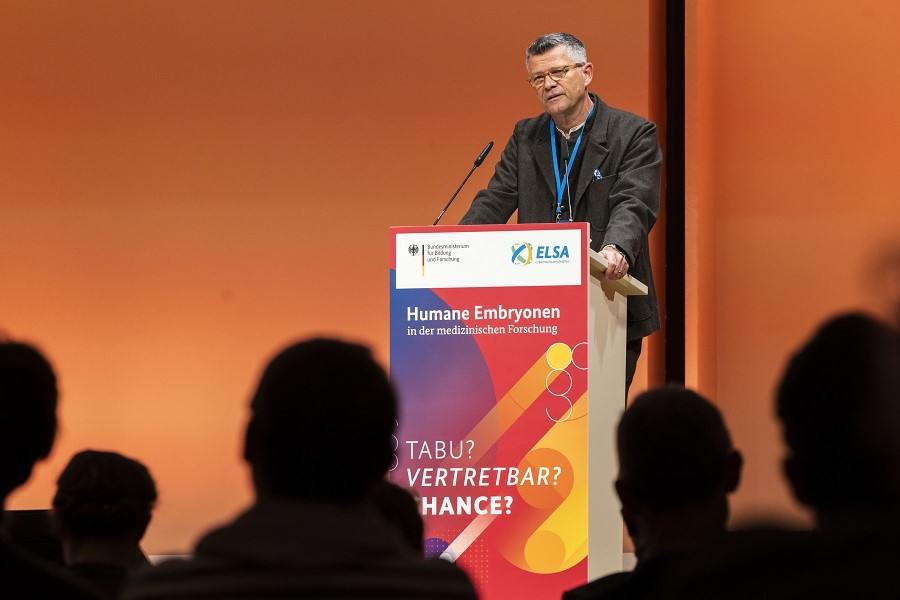
Prof Dr Peter Dabrock, University of Erlangen-Nuremberg
BMBF / bundesfoto
Interim conclusion
Theologian and ethicist Peter Dabrock summarised the two conference sessions for an initial review. Given the sensitive nature of the subject, the issue of the embryo's status is inevitable and unanimous acceptance in society is unlikely. However, it is important not to create division but to have an objective discussion and enhance general understanding among the public. This is the only way to make decisions and take action in a socially and politically responsible manner.
Dabrock concluded the presentations and discussions from various disciplines with an appeal: “We are responsible for what we do, but also for what we fail to do, even when we know better".
The different perspectives have highlighted that new points of discussion are emerging, especially due to the rapid progress in scientific developments. On the other hand, this should also be seen as a challenge to prevent the potential for conflict from growing, despite the complexity of the issue.
We would need to consider how a compromise could be reached in light of the discussion, taking into account factual, social, spatial and temporal dimensions. Above all, this should be seen as a mutual learning process, aimed at achieving the greatest possible consensus. In this context, he also called for greater participation and public engagement in science to connect with the core of society and make full use of the scope allowed by constitutional law.
Workshops: What aspects should be considered for a new legal regulation?
Building on the previous presentations and discussions, two workshops on the second day focused on how legal regulations in embryo and stem cell research could be further developed. Thesis papers served as the starting point for in-depth and sometimes controversial discussions in both workshops. The critical discussions began with brief keynote speeches by selected experts on the theses presented at the start. The aim of the discussions was to critically evaluate the proposed changes and amendments to the law, particularly by scrutinising regulatory approaches, concepts, and structures from scientific, medical, ethical, and (constitutional) legal perspectives. The participants' suggestions and criticisms were acknowledged and incorporated into the revision of the thesis papers.
Reports from the workshops
Henning Rosenau, a criminal and medical law expert, provided an overview of the key discussion points from the workshop on "Further development of reproductive medicine regulations and their ethical and legal implications for handling surplus embryos".
Workshop 1
He emphasised that there was agreement on the fundamental points. The discussion focused on: a) the surplus embryo in vitro (and not the production of embryos for research), b) research for high-level goals and c) the importance of informed consent as a basic requirement. For a reformed regulation, Germany could draw on numerous examples from other countries and already has reliable, proven regulatory authorities as a foundation. In addition, many key arguments and courses of action were gathered during the workshop.
The legislator has room to manoeuvre, which comes with a responsibility towards citizens. After all, the need for medical innovation and improved foundational knowledge was clearly demonstrated at the conference. For broad legitimacy, however, it would need to be made clear that "the value of life and the protection of life are not diminished if research on surplus embryos is permitted", and this should be part of a wide social discourse.
Dirk Lanzerath an ethicist and biologist, summarized the discussion from the workshop on the "Framework Conditions for Research on and with Human Pluripotent Stem Cells and Human Cell Structures (‘-oids’)". He emphasised the consensus that the various types of pluripotent stem cells were justified for their intended purposes and that genetic modifications remained incompatible with reproductive purposes. The removal of the research proviso was also unanimously supported to unlock greater therapeutic potential.
Visit Workshop 2 here
However, many details need further consideration, such as whether a legal definition of the embryo is necessary, which objectives qualify as high-level and what the consent procedure should entail.
He pointed out that when reforming legislation, great care must be taken with word choice to avoid polarisation. For meaningful social discourse, the natural sciences must also be conceptually reliable. He also explained that a periodic review had been introduced as a new feature in the proposed changes to the law, aimed at avoiding the rigidity of the current laws and allowing for adaptation in response to advancements in research.
Both commentators emphasised that consistent and coherent legislation was essential. To achieve medical innovations, suitable conditions for research must be created.
Mario Brandenburg (BMBF) takes stock – What comes next?
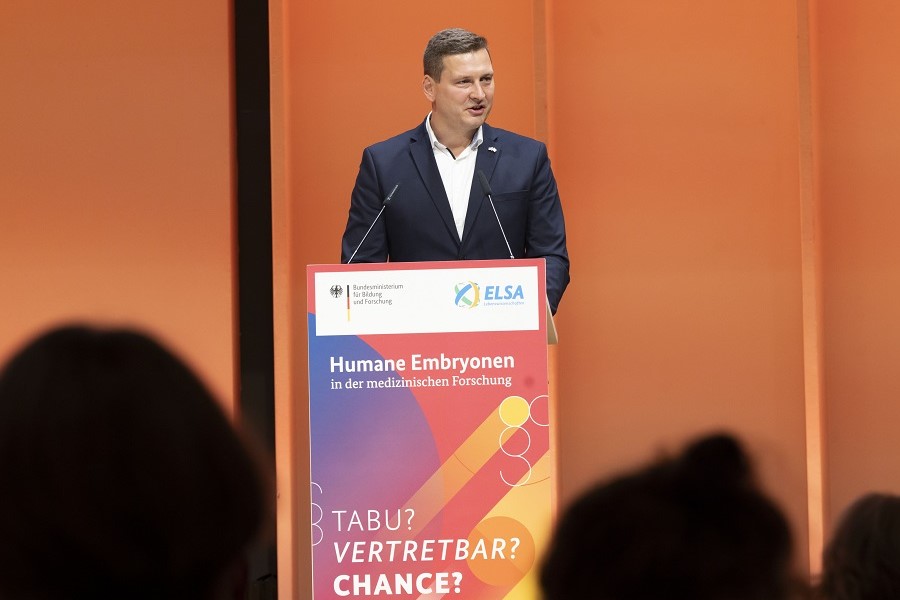
Mario Brandenburg, Parliamentary State Secretary to the Federal Minister of Education and Research
BMBF / bundesfoto
In his closing speech, Mario Brandenburg, Parliamentary State Secretary to the Federal Minister of Education and Research, emphasized the importance of fostering discourse on this topic and highlighting different perspectives. There were diverse perspectives on this topic.
Given that embryo and stem cell research offers the prospect of a cure for patients, we, as a society, need to discuss where the limits should be. To achieve medical innovations, suitable conditions for research must be created. This includes establishing legal certainty for researchers, creating innovation-friendly conditions and fostering international connectivity and cooperation for research and innovation. It is important to openly discuss challenges in a solution-oriented way with society, experts and politicians.
He aimed to take on the challenge of bringing the discourse into the political arena, with the goal of adapting the regulations to meet today’s requirements.